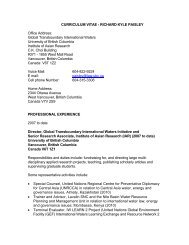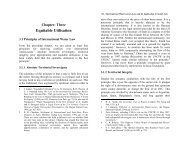Upreti, Trilochan, International Watercourses Law and Its Application ...
Upreti, Trilochan, International Watercourses Law and Its Application ...
Upreti, Trilochan, International Watercourses Law and Its Application ...
You also want an ePaper? Increase the reach of your titles
YUMPU automatically turns print PDFs into web optimized ePapers that Google loves.
42 / <strong>International</strong> <strong>Watercourses</strong> <strong>Law</strong> <strong>and</strong> <strong>Its</strong> <strong>Application</strong> in South Asia Development <strong>and</strong> Codification of <strong>International</strong> <strong>Watercourses</strong> <strong>Law</strong> / 43have an adverse effect in its territory. The arbitral tribunal heldthat the proposed diversion would not violate the treaty becausethere would be no net alteration to the flow of the Carol River."…the tribunal expressed its view that underexisting customary international law co-riparianstates are equally entitled to reasonable use of thewaters from an international drainage basin <strong>and</strong>its view regarding a co-riparian consent;…that there exists a principle prohibiting theupstream state from changing the waters of a riverin their natural condition to the serious injury of adownstream state. Such principle cannot beapplied to the present case because the tribunalhas established, in regard to the first questionexamined above, that the French project does notalter the waters of Carol." 70Therefore, Spain was only entitled to the adoption by France ofmeasures ensuring the reasonable protection of Spain’s interest.When one examines the question of whether France, either incourse of dealing or in her proposals has taken the Spanishinterest into sufficient consideration, it must be stressed howclosely linked together are the obligations to take intoconsideration the violation of interests in the course ofnegotiation, <strong>and</strong> the obligation to give reasonable place to thoseinterests in the adopted solution. A state that has conductednegotiations in good faith in accordance with Article II of theAdditional Act is not excused from giving a reasonable place toadverse interest in the solution it adopts, even if negotiationshad been interrupted owing to the intransigence of its partner. 71The significant aspect of the judgement is the clear <strong>and</strong>unequivocal answer to Spain’s assertion as to “whether Francemust have her consent before initiation of the project according70 Supra note 68, p. 167.71 Ibid.to the customary international law.” 72 The ruling said no; thereis no provision in customary international law that an upstreamcountry is compelled to have consent from her downstreamneighbour before initiating a water project. It can be argued thathad not this point been made clear by the tribunal, there wouldbe the danger of the downstream state having a veto over thematter. In the event of such a ruling, equitable entitlement ofthe upstream state could be jeopardised.Thus, from the analysis of the judgement, a number ofsubstantive principles have emerged. It appears that adownstream state has no veto power to stop or object to anyproject in the upstream state unless it inflicts substantial orserious or significant adverse effects. Therefore, it is a duty ofthe state that is proposing to develop a project to consult <strong>and</strong>negotiate with its co-riparian state in order to identify whetherany adverse affect may be inflicted by such work <strong>and</strong> to ensurethe equitable utilisation of such shared watercourses. It is,therefore, a milestone judgement that has far-reachingimplications in IWL.2.4.4 Gut Dam Case 1968, Canada v. USAThe St. <strong>Law</strong>rence River is one of the principal rivers in NorthAmerica <strong>and</strong> the main outlet for the Great Lakes. Lake Ontariois situated between Canada <strong>and</strong> the United States. It receivesthe drainage of the entire Great Lakes system through theNiagara River <strong>and</strong> discharges into the St. <strong>Law</strong>rence River. Withthe consent of the US, Canada constructed a dam betweenAdams Isl<strong>and</strong> in Canadian territory <strong>and</strong> Les Gallops Isl<strong>and</strong> ofUS territory in St. <strong>Law</strong>rence River in order to improvenavigation. However, a condition of this consent was not tocause any adverse effect in US territory or to its citizens. Incase of such impact, Canada had agreed to pay compensation72 24 ILR (1961), pp. 101-105. This “consent in case of harm” principlewas not recognised in the 1929 Treaty between Norway <strong>and</strong> Swedenwhich has been evaluated later below.












